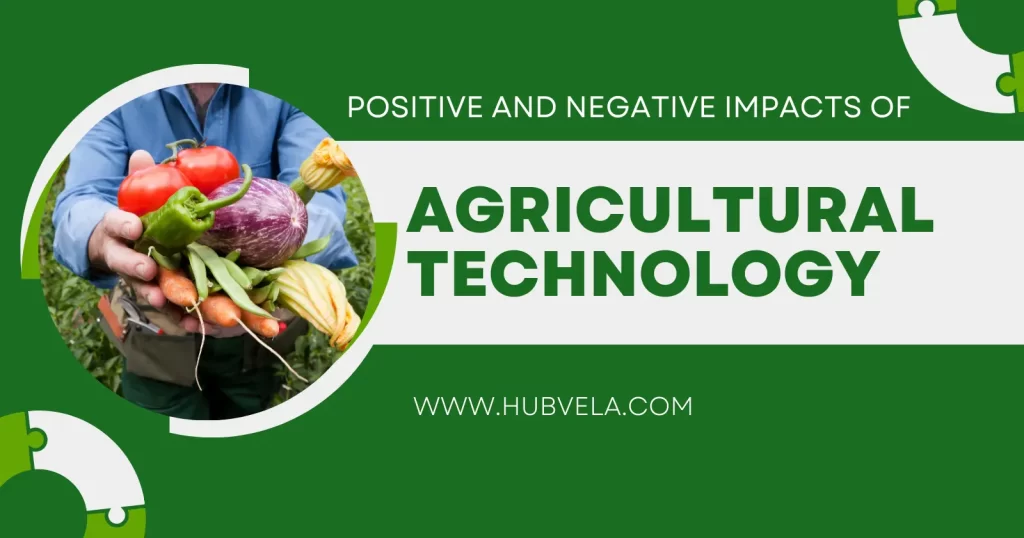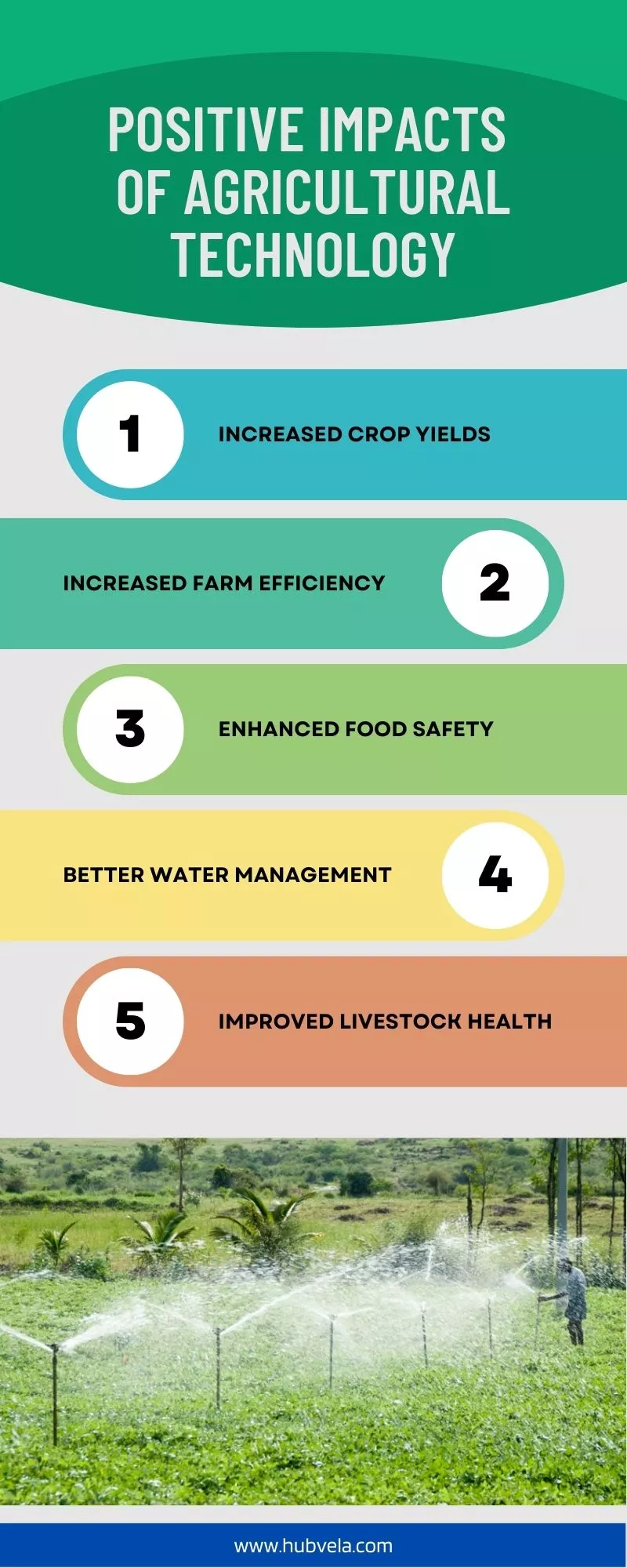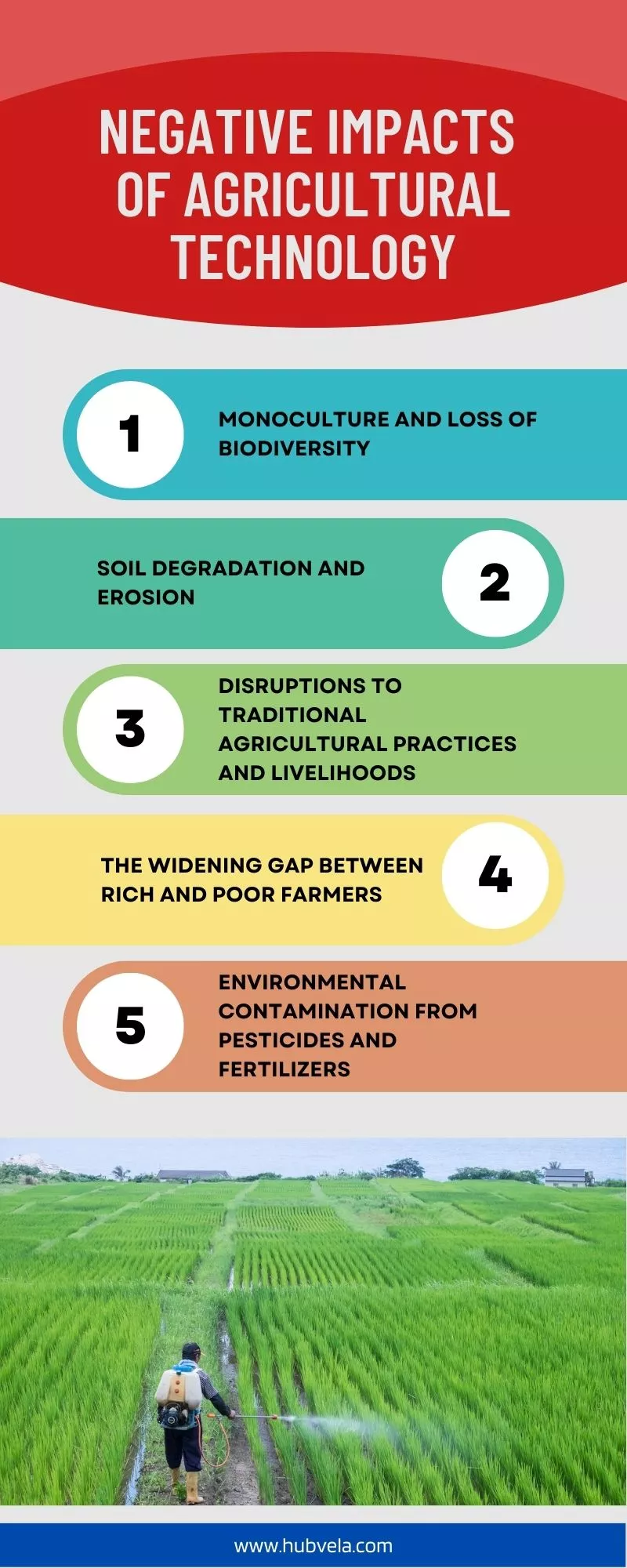Agricultural technology has revolutionized the way we produce food, making it possible to feed a growing global population.
However, like any other technology, it has both positive and negative impacts on the environment and society.
On one hand, agricultural technology has increased crop productivity and reduced the use of water, fertilizer, and pesticides.
On the other hand, it has also caused water and air pollution, soil degradation, and reductions in biodiversity.
In this article, we will explore the positive and negative impacts of agricultural technology in more detail.

--Advertisement--
Positive Impacts of Agricultural Technology
Agricultural technology has revolutionized the way we produce food and has had a significant impact on society.
The use of technology in agriculture has led to higher crop productivity and decreased use of water, fertilizer, and pesticides, which in turn keeps food prices low and reduces the environmental impact of farming.
As production has intensified, the carrying capacity of the land has increased along with the availability of food.
Agricultural technology also increases employment opportunities, efficiency in the production of food, saving time, and reduction in costs.
Let’s explore some of the major positive impacts of agricultural technology.

1. Increased Crop Yields
The use of technology in agriculture has led to higher crop productivity and decreased use of water, fertilizer, and pesticides.
Technology has transformed farming to dramatically increase agricultural productivity by reducing manual labor and time costs.
Precision technologies have been developed that help farmers increase crop yields by monitoring plant growth and identifying factors that affect it.
McKinsey & Company suggests that agriculture must embrace a digital, connectivity-fueled transformation in order to overcome increasing demand and several disruptive forces.
Overall, the use of technology in agriculture has led to increased crop yields and more efficient farming practices.
2. Increased Farm Efficiency
With the use of modern machines and technological advancements, farmers can now collect data, analyze efficiency, monitor growth and quality, and more to save time and resources.
This has led to greater efficiencies and lower prices in agriculture.
Additionally, digital technology can help revolutionize agriculture and the global food production system to make it more resilient, more productive, and sustainable.
By embracing a digital transformation fueled by connectivity, agriculture can overcome increasing demand and several disruptive forces.
Overall, agricultural technology has played a crucial role in increasing farm efficiency while reducing environmental impact.
3. Enhanced Food Safety
Technology is playing a significant role in enhancing food safety. There are various ways technology is helping maintain safe food storage, preparation, and service.
For instance, disinfectant sprays, ultraviolet (UV-C) lighting, and ozone gas are some of the technologies that help improve food safety.
Predictive analytics is another technology that helps stem outbreaks of foodborne illnesses by analyzing big data to uncover patterns and indicators.
Technological solutions enhance food safety protocols and make it faster, more accurate, and more efficient to conduct inventory and auditing.
Overall, technology can increase safety, quality, accuracy, productivity, and efficiency while reducing or eliminating risks.
4. Better Water Management
Better water management is an important aspect of agricultural technology that can have positive impacts on food production and the environment.
According to the OECD, sustainable water management is integral to the future of food and agriculture.
The World Bank notes that technological innovations combined with changes in policy are playing an increasingly important role in agricultural water management.
Agricultural technology can help increase crop productivity while decreasing the use of water, fertilizer, and pesticides, which in turn keeps food prices down.
Water management practices can also have a significant impact on production, economics, and society as a whole.
By improving water management practices through agricultural technology, we can ensure a more sustainable future for agriculture and the environment.
5. Improved Livestock Health
Livestock farming technology can enhance or improve the productivity capacity, welfare, or management of animals and livestock.
With the help of technology, farmers can monitor and manage the health of their livestock more effectively.
For example, precision farming involves the use of technology to monitor and manage the keeping of farm animals.
This can lead to better animal welfare and improved productivity.
By using agricultural technology, farmers can also decrease the use of antibiotics and other medications that may harm animal health in the long run.
Overall, agricultural technology has a significant impact on improving livestock health and welfare.
Negative Impacts of Agricultural Technology
Agricultural technology has brought many benefits to the farming industry, including increased productivity and efficiency.
However, it has also had negative impacts on the environment and human health.
The use of chemical fertilizers and pesticides has led to soil degradation, water pollution, and a reduction in biodiversity.
We will explore some of the major negative impacts of agriculture technology.

1. Monoculture and Loss of Biodiversity
Monoculture is a farming practice where only one crop is grown on a large scale.
While it has some advantages such as simplicity and increased efficiency, it also has negative impacts on the environment and biodiversity.
Monoculture can lead to soil degradation, reduced biodiversity, and increased economic risk for farmers.
Planting the same crop repeatedly in the same area can deplete the soil of nutrients, making it less fertile over time.
This can also lead to an increase in pests and diseases that target that particular crop. The loss of biodiversity due to monoculture farming can have far-reaching consequences for ecosystems and food security.
Therefore, it is important to consider sustainable agricultural practices that promote biodiversity conservation while ensuring food security.
2. Soil Degradation and Erosion
Soil erosion is a gradual process that occurs when the impact of water or wind detaches and removes soil particles, causing the soil to deteriorate.
Erosion is caused by many different factors, but poor soil management, including tilling, can cause significant erosion over time.
These impacts include compaction, loss of soil structure, nutrient degradation, and soil salinity. Soil erosion is a major environmental threat to sustainability and productivity with knock-on effects on the climate.
Erosion causes a deficiency in basic nutrients (nitrogen, phosphorus, potassium, calcium), essential for agricultural production.
Therefore, it is important to manage agricultural technology properly to prevent these negative impacts on soil degradation and erosion.
3. Increased energy consumption and greenhouse gas emissions
The use of agricultural technology has led to increased energy consumption and greenhouse gas emissions.
Agriculture is a major contributor to global greenhouse gas emissions, accounting for 26% of total emissions.
The use of technology in agriculture has led to increased energy consumption, which in turn contributes to greenhouse gas emissions.
While changes in agricultural production could result in reduced greenhouse gas emissions and the removal of carbon dioxide from the atmosphere through carbon sequestration.
It is important to consider the negative impacts that agricultural technology can have on the environment.
It is crucial to develop and implement climate-smart agriculture practices that reduce greenhouse gas emissions while increasing productivity and resilience.
4. The Widening Gap between Rich and Poor Farmers
The use of agricultural technology has led to a widening gap between rich and poor farmers.
While large-scale farmers can afford to invest in expensive technologies, small-scale farmers cannot, leading to a disparity in productivity and income.
This gap is further exacerbated by the lack of government funding for agriculture research and development. As a result, small-scale farmers are unable to compete with larger farms, leading to poverty and food insecurity.
While sustainable agricultural practices can have positive impacts on the environment and people, the negative effects of agricultural technology on small-scale farmers must be addressed in order to promote equitable growth in the agriculture sector.
5. Reduction in employment opportunities
The use of technology in agriculture has been a topic of concern for many people, as it may lead to a reduction in employment opportunities.
Some studies suggest that mechanization and the deployment of innovative technology may decrease the demand for labor in agriculture.
However, others argue that if the agricultural sector thrives, it will indirectly increase employment in other sectors.
It is worth noting that farm incorporations, where farm owners become wage and salary workers, have also contributed to changes in agricultural employment.
Conclusion on the Positive and Negative Impacts of Agricultural Technology
The impact of agricultural technology is a complex issue with both positive and negative effects. On the one hand, modern agricultural technology has increased efficiency in food production, saved time, and reduced costs.
It has also led to higher crop productivity and decreased use of water, fertilizer, and pesticides.
On the other hand, technology in agriculture has had many negative effects on the environment such as water and air pollution, reductions in biodiversity, and soil degradation.
However, agriculture can also positively impact the environment by reducing greenhouse gas emissions through carbon sequestration and improving soil health through conservation practices.
Therefore, it is important to carefully consider both the positive and negative impacts of agricultural technology when making decisions about its implementation.


